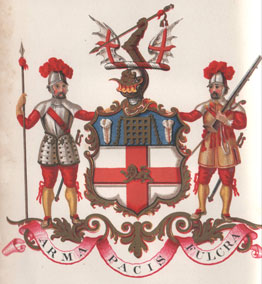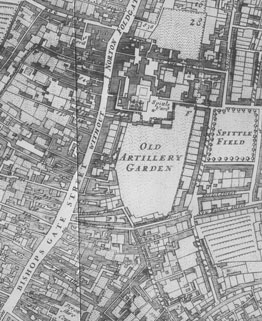The London Trained Bands

Armourial Bearings of the Honourable Artillery Company

The location of the Artillery Garden at Bishopsgate in 1675
The London Trained Bands were the City of London’s militia, composed of householders who fulfilled their statutory obligation to maintain arms and serve in the defence of their City. They were under the jurisdiction of the Lord Mayor and were commanded by officers appointed by him and the aldermen.
Members of the Trained Bands met regularly at the Artillery Garden in Bishopsgate and the Military Garden in St Martin’s-in-the-Field to practice weapon handling, drilling and other military activities under the guidance of officers from the Honourable Artillery Company. These officers made the Trained Bands an effective force, providing professional training for its part-time members.
Following the king’s attempt to arrest the five Members of Parliament in January 1642, a joint committee of the House of Commons and the City’s Committee of Safety appointed Sergeant-Major General Philip Skippon commander of the Trained Bands. He reformed the old North, South, East and West regiments, creating new regiments with colonels and captains appointed from the old formations. Vacant positions in the new regiments were filled through the promotion of subalterns or the granting of commissions to recent graduates of the Honourable Artillery Company. Rank-and-file recruitment was also extended to include all able-bodied men within the areas of the City from where the Trained Bands had traditionally recruited.
The six new regiments were identified by a colour (Red, White, Yellow, Blue, Green and Orange) and were each around 1,200 men strong. They represented one or more of the City’s wards and were ranked in accordance of the status of their colonels.
The Red regiment was the first in order of precedence. Its ensign was a dark red background with notable white wavy rays and was recruited from the wards of Aldgate, Tower and Billingsgate.
The next ranked unit was the White regiment. The regimental colours were a white background with red diamonds and it recruited from the wards of Cornhill, Langbourne, Lime Street, Broad Street and Bishopsgate.
Next was the Yellow regiment. Its ensign was distinguished by black mullets with a yellow background and the regimental limits were the wards of Farringdon Within, Castle Baynard and Aldersgate.
Fourthly was the Blue regiment with its ensign consisting of white roundels based on a blue background. It was recruited from the wards of Bridge, Walbrook, Bread Street, Candlewick, Dowgate, Vintry, Cheap and Queenhithe.
The penultimate unit was the Green regiment, with an ensign that consisted of calthrops on a green background. The regiment was recruited in the wards of Coleman Street, Bassishaw and Cripplegate.
The final unit was the Orange regiment. The colours of the regiment were white trefoils on an orange background. This was the only regiment recruited outside the city wall, from the ward of Farringdon Without.
These regiments, and the Trained Bands of Westminster, Southwark and Tower Hamlets, which at the start of the war were also placed under the control of Skippon and the Militia Committee, were augmented early in 1643 by the creation of six auxiliary regiments of foot (known as the Green, White, Yellow, Red, Blue and Orange auxiliaries), and a regiment of dragoons.
Although the London Trained Bands were used primarily to defend London, at least two regiments marched out from the City with the Earl of Essex’s army in November 1642 to confront the royalists at Turnham Green. Selected Trained Band regiments were involved in the relief of Gloucester and first battle of Newbury in the late summer of 1643. Following this campaign, they marched to secure Newport Pagnell, besieged Basing House and fought at the battle of Alton and the storming of Grafton House. In 1644 Trained Band regiments took part in the battles of Cheriton and Cropredy Bridge, Essex’s western campaign which ended in disaster at Lostwithiel, and the second battle of Newbury in October.
After the Newbury campaign in 1644 the Trained Bands were not again involved on the battlefield. This was due largely to the rise of the New Model Army, as well as the reluctance of the City authorities and the soldiers themselves for the Trained Bands to participate in operations outside the immediate vicinity of the capital. But they continued to defend London until the end of the Civil Wars.

